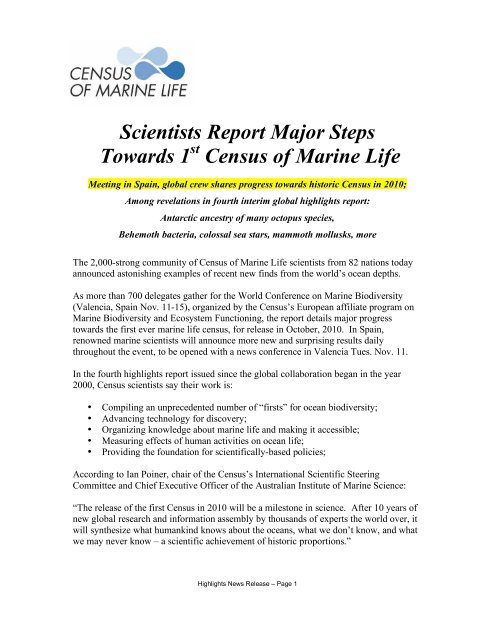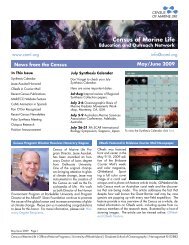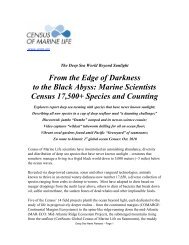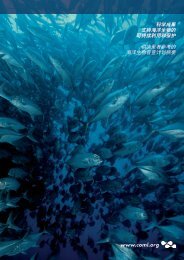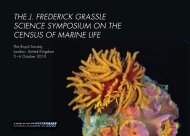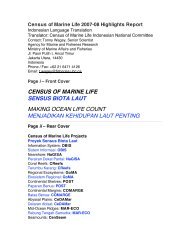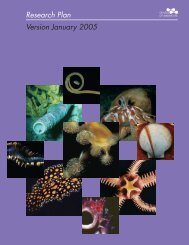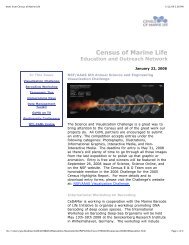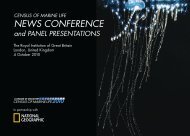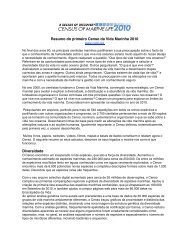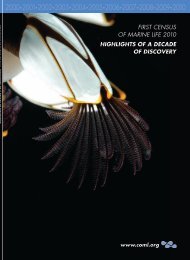Full press release - Census of Marine Life
Full press release - Census of Marine Life
Full press release - Census of Marine Life
You also want an ePaper? Increase the reach of your titles
YUMPU automatically turns print PDFs into web optimized ePapers that Google loves.
Scientists Report Major StepsTowards 1 st <strong>Census</strong> <strong>of</strong> <strong>Marine</strong> <strong>Life</strong>Meeting in Spain, global crew shares progress towards historic <strong>Census</strong> in 2010;Among revelations in fourth interim global highlights report:Antarctic ancestry <strong>of</strong> many octopus species,Behemoth bacteria, colossal sea stars, mammoth mollusks, moreThe 2,000-strong community <strong>of</strong> <strong>Census</strong> <strong>of</strong> <strong>Marine</strong> <strong>Life</strong> scientists from 82 nations todayannounced astonishing examples <strong>of</strong> recent new finds from the world’s ocean depths.As more than 700 delegates gather for the World Conference on <strong>Marine</strong> Biodiversity(Valencia, Spain Nov. 11-15), organized by the <strong>Census</strong>’s European affiliate program on<strong>Marine</strong> Biodiversity and Ecosystem Functioning, the report details major progresstowards the first ever marine life census, for <strong>release</strong> in October, 2010. In Spain,renowned marine scientists will announce more new and surprising results dailythroughout the event, to be opened with a news conference in Valencia Tues. Nov. 11.In the fourth highlights report issued since the global collaboration began in the year2000, <strong>Census</strong> scientists say their work is:• Compiling an unprecedented number <strong>of</strong> “firsts” for ocean biodiversity;• Advancing technology for discovery;• Organizing knowledge about marine life and making it accessible;• Measuring effects <strong>of</strong> human activities on ocean life;• Providing the foundation for scientifically-based policies;According to Ian Poiner, chair <strong>of</strong> the <strong>Census</strong>’s International Scientific SteeringCommittee and Chief Executive Officer <strong>of</strong> the Australian Institute <strong>of</strong> <strong>Marine</strong> Science:“The <strong>release</strong> <strong>of</strong> the first <strong>Census</strong> in 2010 will be a milestone in science. After 10 years <strong>of</strong>new global research and information assembly by thousands <strong>of</strong> experts the world over, itwill synthesize what humankind knows about the oceans, what we don’t know, and whatwe may never know – a scientific achievement <strong>of</strong> historic proportions.”Highlights News Release – Page 1
“Dedication and cooperation are enabling the largest, most complex program everundertaken in marine biology to meet its schedule and reach its goals. When the programbegan, such progress seemed improbable to many observers.”In 2010, the first global <strong>Census</strong> will relate:• Distribution <strong>of</strong> animals in the ocean and their changing ranges;• Diversity as the total number <strong>of</strong> species in the ocean (known and unknown);• Abundance <strong>of</strong> major species groups and how they have changed over time;With regard to distribution, the <strong>Census</strong> will <strong>of</strong>fer:• Range maps for known marine species;• Major global traffic patterns <strong>of</strong> top marine species;• Global maps <strong>of</strong> species richness, showing hotspots and the extent <strong>of</strong> biodiversityin the oceansWith regard to diversity, the <strong>Census</strong> will <strong>of</strong>fer:• A complete list <strong>of</strong> named marine species, likely to range between 230,000-250,000, as well as fresh estimates <strong>of</strong> species yet to be discovered;• Web pages for the great majority <strong>of</strong> the named species, compiled in cooperationwith the Encyclopedia <strong>of</strong> <strong>Life</strong>;• DNA identifiers (“barcodes”) for many speciesWith regard to abundance, the <strong>Census</strong> will <strong>of</strong>fer:• New estimates <strong>of</strong> biomass at various levels in the food chain and for selectedspecies;• Estimates <strong>of</strong> changes in the relative frequency <strong>of</strong> small versus large animals;• Estimates <strong>of</strong> abundance that has been or might be lost soon.* * * * *Top highlights, fourth progress report <strong>of</strong> the <strong>Census</strong> <strong>of</strong> <strong>Marine</strong> <strong>Life</strong>:Antarctic ancestry <strong>of</strong> many deep-sea octopuses worldwideWithin their mandate "to assess and explain the diversity, distribution, and abundance <strong>of</strong>marine life in the oceans – past, present, and future,” <strong>Census</strong> <strong>of</strong> Antarctic <strong>Marine</strong> <strong>Life</strong>scientists report the first molecular evidence that a large proportion <strong>of</strong> deep sea octopusspecies worldwide evolved from common ancestor species that still exist in the SouthernOcean.Octopuses started migrating to new ocean basins more than 30 million years ago when, asAntarctica cooled and a large icesheet grew, nature created a “thermohaline ex<strong>press</strong>way,”a northbound flow <strong>of</strong> tasty frigid water with high salt and oxygen content.Highlights News Release – Page 2
Isolated in new habitat conditions, many different species evolved; some octopuses, forexample, losing their defensive ink sacs – pointless at perpetually dark depths.This revelation into the global distribution and diversity <strong>of</strong> deep sea fauna, to be reportedNov. 11 in the journal Cladistics, was made possible by intensive sampling during<strong>Census</strong> International Polar Year expeditions.Highlights on <strong>of</strong>fer include as well:Distribution:• Scientists discover both a “White Shark Café” and a “sturgeon playground” in thePacific, as others explore life on a “new continent” in the mid-Atlantic, in oceaniccanyons, around Earth’s deepest hot vents, and in the world’s coldest, saltiestseawater;Diversity:• Deep sea explorers discover new forms <strong>of</strong> life, including behemoth bacteria,colossal sea stars, astonishing Antarctic amphipods and a mammoth mollusk, andfind familiar species in many new places. Experts also estimate that, beyond the16,000 marine fish species already known to science, another 4,000 awaitdiscovery, many <strong>of</strong> them in the tropics.Abundance:• Researchers find a sea floor carpet <strong>of</strong> bugs and a city <strong>of</strong> brittle stars, anddocument bluefin tuna abundance in the early 1900s by scouring fishery reports,fishing magazines and other records.Meanwhile, the Ocean Biogeographic Information System has grown to include morethan 120,000 species. And a rapidly-expanding reference library <strong>of</strong> DNA barcodes <strong>of</strong>marine species recently helped reveal inaccurate labeling <strong>of</strong> sushi in New York City andelsewhere.As well, the national and regional networks expediting much <strong>of</strong> the <strong>Census</strong> workexpanded from 10 to 12 since 2006. They and the field projects <strong>of</strong> the <strong>Census</strong> establishedprecedent-setting ethical standards for marine research.* * * * *Appendix 1: Quotable quotes from senior <strong>Census</strong> <strong>of</strong>ficials.Appendix 2: All 58 highlights, clustered in seven categories:• Exploring the unexplored;Highlights News Release – Page 3
• Discovering new forms <strong>of</strong> life;• Finding the unexpected;• Advancing technology;• Building global partnerships;• Informing decisions;• Sharing knowledge.Appendix 3: Partners and sponsorsAppendix 1: Quotable quotes* * * * *Deep sea biologist Paul Snelgrove (Canada), leader <strong>of</strong> the team integrating findings fromall 17 <strong>Census</strong> projects: “We expect to have much-improved tools for predicting thepresence or absence <strong>of</strong> various species based on what we know about a particularenvironment,” he says. “In fact, the <strong>Census</strong> may <strong>of</strong>fer a new map, a new biogeography,<strong>of</strong> all ocean life.”Mollusk expert Patricia Miloslavich (Venezuela), <strong>Census</strong> co-senior scientist: “We arebeginning to pull together a picture and clarify the complicated and interconnected globaldrivers <strong>of</strong> marine biodiversity patterns and changes, and we are starting to see theconservation-related implications and benefits, from the small coves <strong>of</strong> the near-shore tothe vast abyss.”Squid expert Ron O’Dor (Canada), <strong>Census</strong> co-senior scientist: “Not only do we have abetter picture <strong>of</strong> the distribution <strong>of</strong> the animals that stay in place, we are approaching aglobal picture <strong>of</strong> the movements <strong>of</strong> animals, whether swirling in eddies the size <strong>of</strong>Ireland, or commuting 8,000 kilometers across ocean basins. And understanding howbehavior and the environment combine to determine the movement <strong>of</strong> many animals iswithin reach.”Deep-sea explorer Myriam Sibuet (France), vice-chair <strong>of</strong> the <strong>Census</strong>: “The im<strong>press</strong>ivenumber <strong>of</strong> landmark findings over the past two years reveals the richness <strong>of</strong> what remainsto be discovered. The vastness <strong>of</strong> the ocean and our new research tools keep marinebiology forever young.”Biological oceanographer and marine microbiologist Victor Gallardo (Chile), vice-chair<strong>of</strong> the <strong>Census</strong>: “<strong>Census</strong> leadership <strong>of</strong> the Arctic and Antarctic biodiversity research forthe International Polar Year reflects the significance <strong>of</strong> recent activity. In 2007 and 2008alone, <strong>Census</strong> scientists participated in more than 30 research expeditions.”Coastal ecologist Carlo Heip (Netherlands), Valencia Conference Chair and member,<strong>Census</strong> Scientific Steering Committee: “As a European, I am pleased that EuropeanUnion support for the MarBEF program laid the foundation for this World Conference on<strong>Marine</strong> Biodiversity. I am especially pleased that the location is Spain, home <strong>of</strong> manyHighlights News Release – Page 4
dynamic contributors to MarBEF and the <strong>Census</strong>, including Eva Ramirez Llodra andCarlos Duarte.”Dr. Ian Poiner (Australia), Chair, <strong>Census</strong> <strong>of</strong> <strong>Marine</strong> <strong>Life</strong> Scientific Steering Committeeand Chief Executive Officer, Australian Institute <strong>of</strong> <strong>Marine</strong> Science: “We are thrilledwith the quality <strong>of</strong> our collaborations, for example, with the French film company,Galatee, whose spectacular Oceans film will debut in about a year. And with newsponsors, including many government agencies and also organizations such as theNippon Foundation, and companies, including Total, Chevron, Petrobras, and BHPBilliton, which have joined this bold venture. Ten years ago many ex<strong>press</strong>ed skepticismabout a <strong>Census</strong> <strong>of</strong> <strong>Marine</strong> <strong>Life</strong> but now we know that, with many working together, it can– and must urgently – be done.”* * * * *Appendix 2: Fourth Highlights Report, <strong>Census</strong> <strong>of</strong> <strong>Marine</strong> <strong>Life</strong>The 17 <strong>Census</strong> projects have acronym nicknames such as MAR-ECO. For the projects’full names and missions, Internet links are provided below in the first reference.EXPLORING THE UNEXPLORED1) Exploring a “new continent” in mid-AtlanticMAR-ECO (www.coml.org/descrip/mareco.htm) scientists describe their work as“surveying a new continent half way between America and Europe.” Sampling along theMid-Atlantic Ridge at depths down to 2,500 meters, they find many hundreds <strong>of</strong> speciesrare or unknown elsewhere in the world and collect environmental data to help explaintheir distribution and abundance.2) World’s deepest known active hot ventChEss (www.coml.org/descrip/chess.htm) scientists in the Mid-Atlantic Ridgeexplore the world’s deepest known active hot vent, field named Ashadze, over 4,100meters deep, dominated by anemones, polychaete worms and shrimp. They alsodiscover marine environments with little or no oxygen harboring more life than expected.3) Bacterial mats in Black SeaChEss scientists also find reefs deep in the Black Sea made <strong>of</strong> bacterial mats usingmethane (natural gas) as an energy source, the bacteria forming spectacular chimneys upto four meters high. Such reefs could contribute key insights into mechanisms controllingemissions <strong>of</strong> methane, an important greenhouse gas, from the ocean to the atmosphere.4) Brittle Star CityHighlights News Release – Page 5
Exploring <strong>of</strong>f the coast <strong>of</strong> New Zealand, CenSeam(www.coml.org/descrip/censeam.htm) researchers capture images <strong>of</strong> a novel “Brittle StarCity,” whose inhabitants colonize the peak <strong>of</strong> a seamount – an underwater summit tallerthan the world’s tallest building. In a swirling circumpolar current flowing at roughlyfour kilometers per hour, tens <strong>of</strong> millions <strong>of</strong> brittle stars live arm tip to arm tip. Thecurrent kept away would-be predators while delivering an ample supply <strong>of</strong> food thatresidents <strong>of</strong> Brittle Star City collected simply by raising their arms.5) Surprisingly different twinsNaGISA (www.coml.org/descrip/nagisa.htm) nearshore scientists in the AlaskanArctic find a site with a rocky seafloor, rare along the normally s<strong>of</strong>t and silty Arcticcoastline. The hard substrate hosts a highly diverse community compared to surroundings<strong>of</strong>t bottom habitat. Comparison <strong>of</strong> this new site to a similar site surveyed by <strong>Census</strong>researchers in 2002 shows surprisingly different communities. <strong>Census</strong> nearshorescientists collaborating with local agencies also discover new species in the Aleutianarchipelago, including a kelp, sea anemones, chitons, snails, and sea stars.6) Pacific hotspotsTOPP (www.coml.org/descrip/topp.htm) researchers discover eddies <strong>of</strong> warm waterin the Pacific may meld, forming hotspots in the open sea that support elevated levels <strong>of</strong>tiny phytoplankton that form the base <strong>of</strong> the marine food web. These green meadows inthe vast Pacific in turn concentrate species from all tiers <strong>of</strong> the food web – from shrimp tolarge predators like tuna, seabirds, and whales.7) Seep mega-sitesCOMARGE (www.coml.org/descrip/c-margins.htm) and ChEss scientists discovermore lively communities flourishing <strong>of</strong>f cold gases such as methane seeping out <strong>of</strong> thesea floor. Around New Zealand, they map the “Builder’s Pencil” site covering about180,000 square meters, among Earth’s largest known seep sites. Sensitive to humanactivities despite their depth, the communities keep revealing unique features. Findingboth potential new species and scars from deep-water trawls by fishing vessels on thescientific surveys suggests the urgency for further conservation <strong>of</strong> these fragile habitats.8) Philippine firstsIn the first deep-sea work in the area, COMARGE researchers sample to a depth <strong>of</strong>2,300 meters, collecting about 300 fish and 400 mollusc species for barcoding. Some 320decapod crustaceans are photographed, displaying their beauty and aiding futureidentification <strong>of</strong> many unique and subtly distinct specimens.In 2008, COMARGE investigators return to explore the Philippine margin <strong>of</strong> theSouth China Sea, between 100 and 2,200 meters depth. Discoveries include the firstPhilippine record <strong>of</strong> the deep-water stony coral Lophelia pertusa, the first livingspecimen <strong>of</strong> Acharax bartschi (a large bivalve living in symbiosis with bacteria), raredeep-water snails living on a dog’s skull that had washed out to sea, and a likely newspecies <strong>of</strong> shrimp belonging to a group only known from hydrothermal vents. The trawlalso collected many plastic shopping bags.Highlights News Release – Page 6
9) Potential new marine protected area, AfricaWhile largely unexplored, the rich Western Indian Ocean, including the Mozambiquechannel, suffers destructive fishing practices, such as use <strong>of</strong> dynamite. <strong>Census</strong>-affiliatedexplorers with the Sub-Sahara African Committee chart a proposed marine protected area<strong>of</strong>f Tanga, Tanzania. Using SCUBA and remotely operated vehicles, Tanzanian scientistsand students join international researchers to survey life along transects that could beperiodically revisited, collecting samples for identification and barcoding.10) <strong>Life</strong> in coldest, saltiest seawaterArcOD (www.coml.org/descrip/aobio.htm) researchers studying life in the Arctic findtemperatures <strong>of</strong> –25°C in sea ice channels where brine is more than six times saltier thanregular sea water. Representing the coldest conditions in the global ocean, researchersfind sea ice algae, such as diatoms, and flagellates thriving in concentrations <strong>of</strong> thousands<strong>of</strong> individuals per liter.DISCOVERING NEW FORMS OF LIFE11) 100 new species and records near HawaiiCReefs (www.coml.org/descrip/c-reefs.htm) experts census biodiversity in the FrenchFrigate Shoals, the world’s largest, fully protected marine area in the NorthwesternHawaiian Islands. Using a variety <strong>of</strong> new and proven methods over a diverse range <strong>of</strong>habitats, the team logs more than 100 species and new records.12) Carpet <strong>of</strong> bugsCOMARGE researchers describe a new species <strong>of</strong> amphipod, Ampeliscamississippiana, inhabiting the head <strong>of</strong> the Mississippi Canyon about 460 meters deep inthe Gulf <strong>of</strong> Mexico. These small crustaceans (less than 6 millimeters in length) andliving in tubes, carpet the seabed in densities up to 12,000 individuals per square meter.Based on its abundance and the stabilizing effects this “carpet <strong>of</strong> bugs” has on sediments,researchers believe this amphipod may have great ecological importance.13) Deepest comb jellyCMarZ (www.coml.org/descrip/cmarz.htm) explorers find a potential new species <strong>of</strong>comb jelly, or ctenophore, at the record depth <strong>of</strong> 7,217meters in the Ryukyu Trench nearJapan – the deepest ever recorded siting <strong>of</strong> this unique species, that flies like a kite on theend <strong>of</strong> two long “strings” attached to the bottom. The discovery raises questions aboutthe availability <strong>of</strong> food resources at such depths, which had not been thought capable <strong>of</strong>supporting predators like this one.14) Evolutionary molluskIn the Southern Ocean, CAML (www.coml.org/descrip/caml.htm) researchers findmany potential new species including sea cucumbers, sponges and komokiaceans – littleknown protozoa living in the depths <strong>of</strong> the ocean resemble the organisms that form chalk.Highlights News Release – Page 7
They also collect a rare mollusk, named Laevipilina antarctica, believed to play a role inhow segmentation evolved in marine invertebrates.15) Arctic jellies galoreIn the Canada Basin <strong>of</strong> the Arctic Ocean, ArcOD researchers find several new speciesand more than 50 taxonomic categories <strong>of</strong> gelatinous zooplankton. Almost two-thirds aremedusae, one-fifth siphonophores, and one-tenth larvaceans. The first new speciesformally described from the expedition was named Sigambra healyae, in honor <strong>of</strong> theresearch vessel, the U.S. Coast Guard Cutter Healy.16) 85 new zooplankton speciesCMarZ scientists discover at least 85 new species <strong>of</strong> zooplankton, small drifting andswimming marine animals. Four genera and one family were <strong>of</strong>ficially deemed new toscience, with many more expected to follow. In the Atlantic Ocean from Germany toSouth Africa, scientists collect zooplankton in a range from the surface to below 5,000meters. Taxonomic experts and geneticists identify and barcode the DNA from hundreds<strong>of</strong> species. As expected, several new species <strong>of</strong> small crustaceans called ostracods or seedshrimp and other groups are found.17) Antarctica’s big amphipodCAML scientists exploring a 10,000 kilometer portion <strong>of</strong> the Antarctic Weddell Seamade suddenly accessible by the collapse <strong>of</strong> the Larsen A and B ice shelves sample anestimated 1,000 species. Of these, four presumed new species <strong>of</strong> cnidarians (organismsrelated to coral, jelly fish and sea anemones) are found, as well as 15 potentially newamphipod (shrimp-like) species, including one <strong>of</strong> Antarctica’s biggest-ever amphipodcrustaceans, nearly 10 centimeters long.18) Spectacular species in Celebes SeaZooplankton researchers with CMarZ travel to a biodiversity hot spot in the CelebesSea in the southern Philippines, uncovering unexpected richness and diversity <strong>of</strong> marinelife from the surface to the almost totally unexplored deep waters. Divers collect aremarkable variety <strong>of</strong> fragile and beautiful gelatinous species, while video cameras andcollect images and organisms from depths beyond the divers' reach.19) Surprising species richnessRecent advances in technology are opening up remote frontiers – deep-sea canyons.COMARGE researchers aboard the RRS James Cook <strong>of</strong>f Portugal find that speciesrichness was almost double in the more active Nazaré Canyon than in Lisbon Canyon.This is despite Lisbon Canyon receiving a substantial supply <strong>of</strong> river-borne organicmatter that would foster large populations <strong>of</strong> filter-feeding organisms.20) 11,130 known species in South African watersExperts with the <strong>Census</strong>’ Sub-Sahara African Committee estimate 6,000 morespecies, primarily smaller marine animals, are yet to be discovered in South Africanwaters, which are already known to feature some 11,130 species. A new shrimpHighlights News Release – Page 8
(Hippolyte) and the first record <strong>of</strong> the enigmatic group Myzostomida from the region arediscovered in False Bay, the most sampled site on the African coast.21) 870+ squat lobster speciesCOMARGE scientists list 870 known species <strong>of</strong> squat lobsters and create anelectronic library <strong>of</strong> relevant literature. Squat lobsters are colorful decapod crustaceansfound in all oceans, at all depths, and in all marine habitats, but are especially abundanton continental margins.FINDING THE UNEXPECTED22) Antarctic Ex<strong>press</strong>wayIn the Southern Ocean, <strong>Census</strong> CAML explorers find evidence that deep seaoctopuses ride the “Antarctic thermohaline ex<strong>press</strong>way.” The northbound ex<strong>press</strong>way isa mass <strong>of</strong> sea water with a high salt density caused by the ice that forms at the surfacearound the Antarctic, the water cascading like cream.They find as well that sea birds feed on Antarctic zooplankton when the tinyorganisms aggregate at a thermal front.23) Animals in new placesArcOD explorers make the first record <strong>of</strong> many marine animals in many areas <strong>of</strong> theCanada Basin. These include abundant and diverse ctenophore (comb jellies) underArctic pack ice and a dense bed <strong>of</strong> sea cucumbers in what might be a pockmark. Theyalso record more squid than ever before in the Arctic deep sea, and document theimportance <strong>of</strong> sea ice ridges for marine life in the region.24) White Shark CaféSatellite tagging by TOPP reveals a previously unknown behavior <strong>of</strong> white sharks(www.eol.org/taxa/17143484), travelling long distances each winter to concentrate in thePacific for up to six months. During these months, both males and females makefrequent, repetitive dives to depths <strong>of</strong> 300 meters, which researchers theorize may besignificant in either feeding or reproduction.25) Migration pathwayMAR-ECO researchers suggest the Mid-Atlantic Ridge may serve as an importantpathway in colonization <strong>of</strong> North Atlantic continental slopes. Before their expeditions,scientists thought skates and rays, for example, migrated through the Mid-Atlantic Ridge,rather than taking up residence there.26) New species in familiar watersSystematically exploring two islands on the Great Barrier Reef and a reef <strong>of</strong>fnorthwestern Australia, CReefs researchers find hundreds <strong>of</strong> new kinds <strong>of</strong> animals inHighlights News Release – Page 9
waters were long familiar to divers. They also conduct the first scientific inventory <strong>of</strong>spectacular s<strong>of</strong>t corals, named octocorals for the eight tentacles that fringe each polyp.27) Australian expedition: One species in three new to scienceThe first results from the COMARGE “Voyages <strong>of</strong> Discovery” expeditions to thedeep continental shelf and slope in Australia’s southwest region show 524 species <strong>of</strong>Decapoda—crabs, shrimps, prawns, lobsters, and the like. Some 33 percent <strong>of</strong> all speciesencountered are suspected to be new species, and 25 percent are new records in theregion, eight percent are new records for Australia.28) Sponge gardenCOMARGE and ChEss researchers examining cold seeps in the Mediterranean Seausing remotely operated vehicles find surprisingly abundant marine life, including agarden <strong>of</strong> sponges around a brine lake. The sponge itself, likely Rhizaxinella pyrifera,harbours a multitude <strong>of</strong> small worms.29) Behemoth bacteriaA diverse set <strong>of</strong> giant, filamentous, multi-cellular marine bacteria is discovered byICOMM (www.coml.org/descrip/icomm.htm) researchers in the eastern South Pacific.These bacteria may be “living fossils” that developed in the earliest ocean when oxygenwas either absent or much diminished, living on the toxic gas hydrogen sulfide. Scientistshypothesize that communities <strong>of</strong> bacteria may hold potential for bioremediation <strong>of</strong>organically polluted bottoms and, because <strong>of</strong> their ability to survive in anoxic conditions,may be an important clue in the search for extraterrestrial life.30) Colossal sea starsCAML expeditions to the Southern Ocean find frequent examples <strong>of</strong> gigantismcommon in Antarctic waters. The researchers collect huge scaly worms, giantcrustaceans, starfish and sea spiders as big as dinner plates.31) Largest mollusk in classA giant aplacophoran mollusk, Chaetoderma felderi, is collected in deep waters <strong>of</strong>fLouisiana by GoMex, a <strong>Census</strong>-affiliated project working in the Gulf <strong>of</strong> Mexico.Measuring over 407 mm in length and 10 mm in diameter, about the size <strong>of</strong> a AAAbattery, it is more than twice the length and three times the diameter <strong>of</strong> the next largestknown mollusk in the subclass.32) Gigantic oystersWith the assistance <strong>of</strong> a remotely operated vehicle, COMARGE explorers find densecommunities <strong>of</strong> giant oysters 20 cm (eight inches) long at a depth <strong>of</strong> 700 m on the LaChapelle continental slope. Genetic studies will confirm if this is a new species.33) Barcoding zooplanktonADVANCING TECHNOLOGYHighlights News Release – Page 10
An international CMarZ team from 25 cooperating projects is analyzing data fromroughly 6,000 historical samples to help create a catalog <strong>of</strong> described species diversityand distribution. DNA barcodes will identify approximately 7,000 known species <strong>of</strong>zooplankton in 15 phyla. This growing database will help scientists identify specimens,describe their geographic distributions, and recognize when a species is in fact new.Scientists envision a day soon when quick, automated sample barcoding analysis will bea reality.34) Following fishers to find ventsStymied in their search for active methane seeps in the Chilean margin, COMARGEscientists take a novel approach: follow the fishers. They launch their search in knownfishing grounds <strong>of</strong> the Patagonian toothfish (Dissostichus eleginoides), suspecting thatthese fish congregate near methane seeps. Their hunch proves correct: Most fishinggrounds were associated with hard grounds, with some made <strong>of</strong> carbonates associatedwith methane seepages.35) Coral reef colonizationTo learn what new creatures colonize coral reefs, CReefs scientists develop and testAutonomous Reef Monitoring Structures (ARMS), to be colonized by fish and othercreatures that inhabit coral reefs. The structures mimic the “nooks and crannies” <strong>of</strong> anatural reef. With this information, marine scientists can better understand the health <strong>of</strong>reefs and policy makers can develop scientifically-based management strategies.36) Mapping microbesTo identify marine microbes and survey their distribution around the globe, ICoMMlaunches 40 separate projects using the same DNA sequencing technology, “454 tagpyrosequencing.”The efficient identification by a standardized method allows scientiststo inventory areas as diverse as polar biodiversity hotspots, coastal microbial mats, andsediments in tropical coral reefs. They can then create unprecedented global maps <strong>of</strong> thetiniest life in the ocean.37) Arctic robotsTwo new underwater robots give ChEss scientists a bird’s eye view <strong>of</strong> what lives onGakkel Ridge in the Arctic Ocean. These exploration vehicles carry cameras andsophisticated arrays <strong>of</strong> instruments used by scientists to discover a new underwatervolcanic chain covered by extensive microbial mats. Because the deep Arctic ridges areisolated from other ocean basins, the investigation <strong>of</strong> Gakkel Ridge provides clues aboutthe evolution <strong>of</strong> fauna around underwater vents in isolated habitats.BUILDING GLOBAL PARTNERSHIPS38) Nearshore research expands worldwideNaGISA expands nearshore research within the Caribbean, South America, andaround the Indian Ocean through regional workshops aimed at standardizing protocols.Highlights News Release – Page 11
Scientists use these protocols in monitoring and educational program to assessenvironmental impacts and to engage local communities in the process.39) A highly detailed look at biodiversity in a well-documented bayA unique collaboration <strong>of</strong> U.S. and Canadian GoMA(www.coml.org/descrip/gom.htm) researchers enhances knowledge <strong>of</strong> changing marineeco-systems by studying the nearshore zone <strong>of</strong> Cobscook Bay, Maine, from bothhistorical and present-day perspectives. One <strong>of</strong> the most diverse coastal ecosystem on theNorth American east coast north <strong>of</strong> the tropics, this estuary features many differenthabitats, a tidal range <strong>of</strong> over eight meters, two centuries <strong>of</strong> historical records datingback to 1842, and more than 800 species identified to date.40) Engaging the publicNaGISA scientists studying the nearshore environment <strong>of</strong> the world ocean are presenton six continents. Science education programs and training workshops aim to incorporateresearch protocols, which makes data gathered in the coastal environment comparablefrom place to place. The nearshore investigations engage the public in ocean and coastalissues and inspire the next generation <strong>of</strong> marine scientists.41) International study <strong>of</strong> plankton bloomIn the Southern Ocean, collaborating CeDAMar(www.coml.org/descrip/cedamar.htm) researchers follow a plankton bloom from its onsetuntil it changes to marine snow and finally sinks to the deep-sea floor. The scientists thenexamine the influence <strong>of</strong> the snow <strong>of</strong> fallen plankton on marine life on the floor itself. Itis the first such collaboration undertaken since the Galathea expedition in the early1950’s. In spite <strong>of</strong> bad weather and complicated logistics, the collaboration produces atrove <strong>of</strong> data.42) Leading research for International Polar Year<strong>Census</strong> projects play a key role in the International Polar Year 2007-2009. In theArctic, the <strong>Census</strong> leads the marine biodiversity cluster <strong>of</strong> 13 projects from eightcountries on more than 20 expeditions. They observe how mammals use diverse polarhabitats, inventory life in a fjord, and explore seeps, pockmarks, and mud volcanoes onremote ocean floors. In the Southern Ocean, the <strong>Census</strong> coordinates the science on 10major expeditions by vessels from nine different countries, the results reported live viathe Internet. The <strong>Census</strong> also initiates a collaborative program focusing on Antarcticmarine life in seven South American countries.INFORMING DECISIONS43) Race to protect sea turtlesThe Great Turtle Race, an international race developed by TOPP to save a 100-million-year-old species from extinction moved to China in 2008. A Mandarin languageversion <strong>of</strong> an interactive webpage tracks the migration <strong>of</strong> endangered leatherback turtles,bringing the race to approximately 100 million Chinese citizens. Donations go toprotection <strong>of</strong> leatherback turtle nesting areas in Indonesia, and raise awareness <strong>of</strong> theturtles plight.Highlights News Release – Page 12
44) Leatherback conservationFor more than 12,095 satellite-tracking days over three years, TOPP scientists trackleatherback turtles and compile the largest, multi-year migration record ever. The datareveals that ocean currents shaped the migration corridor and turtle dispersal in the SouthPacific.45) Hydrothermal vents and seabed miningChEss scientists orchestrate a joint scientific and policy meeting for the spring <strong>of</strong>2009 to discuss protection <strong>of</strong> the vent sites from the potential growth <strong>of</strong> deep sea mining.The meeting’s goal: set priorities for future research and balance the conservation <strong>of</strong>critical vent sites versus the value <strong>of</strong> ores.46) Focusing fishery managementMAR-ECO research along the Mid-Atlantic Ridge strives to fill information gapsabout the distribution and abundance <strong>of</strong> certain species <strong>of</strong> grenadier(www.eol.org/taxa/17063155), distant relatives <strong>of</strong> codfish in the North Atlantic. Amid theuncertainty, regional managers take precautionary measures to protect grenadier stocksand their habitats.47) CSI in the sea: DNA barcoding shark finsDemand for their fins and other organs impact global shark populations. Thefrequently inaccurate identification <strong>of</strong> sharks and rays confuses what fishermen arecatching, what fins and organs markets are selling, and how populations are changing.Accordingly, researchers with the <strong>Marine</strong> Barcode <strong>of</strong> <strong>Life</strong> project(www.marinebarcoding.org/publications) develop DNA barcoding to identify species <strong>of</strong>sharks and their products, such as dried fins, essential to knowing how many sharks arebeing caught and to enforce prohibitions. (See alsohttp://phe.rockefeller.edu/docs/pacificfishingsept2008.pdf)48) Managing underwater mountainsCenSeam expeditions in the Southern Ocean and Antarctica expand knowledge <strong>of</strong> lifeon seamounts, providing a foundation for sustainable management <strong>of</strong> these ecosystems.<strong>Census</strong> researchers deliver a report to the United Nations General Assembly on thevulnerability <strong>of</strong> seamount corals to fishing and help develop guidelines for deep-seafisheries.49) Learning from the past: Rise and fall <strong>of</strong> tunaScouring fishery reports, fishing magazines, and other records, HMAP(www.coml.org/descrip/hmap.htm) researchers document the presence <strong>of</strong> bluefin tuna(www.eol.org/taxa/17050078) in northern European waters several decades before theonset <strong>of</strong> major fisheries in the early 1900s. After fishing increased and techniques becamemore powerful, the fishery collapsed in the mid-1960s. Documentation <strong>of</strong> the historicalabundance <strong>of</strong> this especially popular seafood species, and its subsequent collapse, will beused to inform future decisions.Highlights News Release – Page 13
50) Assessing human impactHMAP brings together a worldwide network <strong>of</strong> experts from multiple disciplines t<strong>of</strong>igure out why populations <strong>of</strong> mollusc have declined. They report their work in a book,Early Human Impact on Megamolluscs (Oxford: Archaeo<strong>press</strong>).51) High mortality for young salmonUsing acoustic tagging, POST (www.coml.org/descrip/post.htm) researchers track theprogress <strong>of</strong> young Chinook salmon (www.eol.org/taxa/17154704) as they move fromfreshwater rivers in the Canadian and US northwest out to the ocean and eventually to theAlaska coast. The observations suggest that in just a few weeks, 40 percent <strong>of</strong> the trackedsalmon perished in the ocean.52) Sturgeon playgroundPOST researchers discover green sturgeon congregate at a “playground” <strong>of</strong>fVancouver Island before moving on to Alaska for the winter, contrary to scientists’expectations. The reason for their layover is unknown, but it makes them susceptible topotential over-exploitation.53) Conserving life in open oceanMAR-ECO documentation <strong>of</strong> the quantity and patterns <strong>of</strong> diversity on the mid-Atlantic Ridge summit at 3,500 meters helps international management organizationsprotect habitats and assure sustainable resource use. Continued work by <strong>Census</strong> scientistsand a variety <strong>of</strong> partners creates a better basis for conservation <strong>of</strong> marine life in theimmense areas <strong>of</strong> the oceans that lie beyond national jurisdiction.54) Tuna and Billfish distributionFMAP (www.coml.org/descrip/fmap.htm) researchers investigate the globaldistribution patterns <strong>of</strong> two highly migratory predators, tuna and billfish, and relate theinformation to the temperature tolerances <strong>of</strong> these species, work that may help anticipatethe effects <strong>of</strong> ocean warming on biodiversity.SHARING KNOWLEDGE55) OBIS reaches 16 million records<strong>Census</strong> experts creating the Ocean Biogeographic Information System(www.coml.org/descrip/obis.htm), log 16 million biological records, with 17 millionexpected by year’s end, received from nodes around the world. Collaboration with theEncyclopedia <strong>of</strong> <strong>Life</strong>, among others, expedites information sharing, creating an integratedsystem containing geographical, biographical, evolutionary, and genetic information, aswell as images.56) Counting all creatures in the GulfScientists complete a comprehensive inventory <strong>of</strong> all marine life in the Gulf <strong>of</strong>Mexico. Published in a 79-chapter book written by 140 authors from 15 countries, theinventory shows 15,625 species from 40 different phyla in the Gulf. A second phase <strong>of</strong>Highlights News Release – Page 14
the project currently underway will make the information available in a searchable onlinedatabase.57) Listing all species, eliminating aliasesThe list <strong>of</strong> known marine species surpasses 120,000, placing the <strong>Census</strong> halfwaytoward its goal <strong>of</strong> cataloging the estimated 230,000 known species by 2010. The <strong>Census</strong>affiliatedWorld Register <strong>of</strong> <strong>Marine</strong> Species (WoRMS) identifies more than 56,000aliases for ocean species, with one species, the “breadcrumb sponge,” alone having 56scientific names.58) 4,000 <strong>Marine</strong> Fish May Await DiscoveryEmploying a novel approach to count quantify global fish species, FMAPresearchers estimate that almost 16,000 species <strong>of</strong> marine fish are recorded in publiclyaccessible databases. They suggest another 4,000 fish species await discovery anddescription, many <strong>of</strong> them in the tropics.* * * * *Appendix 3: Partners and SponsorsThe <strong>Census</strong> is made possible by support from a broad range <strong>of</strong> private sources andgovernment agencies in nations ranging from Germany, Netherlands, Norway, andPortugal to Argentina, Brazil, China, India, Indonesia, and South Africa. An inclusivelist <strong>of</strong> supporters is available atwww.comlsecretariat.org/Dev2Go.web?id=302846&rnd=27348.Some recent partners and sponsors include:• Alfred P. Sloan Foundation, USA• Australian Antarctic Division, Government <strong>of</strong> Australia• Australian Institute <strong>of</strong> <strong>Marine</strong> Science• BHP Billiton• Bonneville Power Administration, USA• Bureau <strong>of</strong> Fisheries and Aquatic Resources, Philippines• Chevron• Consejo Superior de Investigaciones Científicas, Spain• Commonwealth Scientific and Industrial Research Organisation, Australia• David and Lucile Packard Foundation, USA• Department <strong>of</strong> Oceanography and Center for Oceanographic Research in the EasternSouth Pacific (University <strong>of</strong> Concepción, Chile)• European Union (including HERMES, MARBEF and other programs)• Fisheries and Oceans Canada• Fisheries Research and Development Corporation, Australia• Flanders <strong>Marine</strong> Institute (VLIZ) (host, World Register <strong>of</strong> <strong>Marine</strong> Species and EurOBIS),Belgium• Gordon and Betty Moore Foundation, USA• Government <strong>of</strong> Chile (Ministry <strong>of</strong> Foreign Affairs, Chilean Antarctic Institute, andHighlights News Release – Page 15
Ministry <strong>of</strong> Defence - Air Force)• Group on Earth Observations (GEO)• Ifremer, France• Museum Victoria, Australia• Natural Environment Research Council, UK• National Institute <strong>of</strong> Water and Atmospheric Research, New Zealand• National Oceanic and Atmospheric Administration, Office <strong>of</strong> Ocean Exploration, USA• National Oceanography Centre, UK• National Science Foundation, USA• Natural Sciences and Engineering Research Council, Canada• New Zealand Foundation for Research, Science and Technology• Nippon Foundation, Japan• Petrobras• Richard Lounsbery Foundation, USA• Russian Academy <strong>of</strong> Sciences• Russian Foundation for Fundamental Research, Russia• Stavros Niarchos Foundation, Greece• Total Foundation for the Biodiversity and the Sea, France• University <strong>of</strong> Ghent, Belgium• Universidad Catolica del Norte and Centro de Investigacion, Chile• World BankHighlights News Release – Page 16


